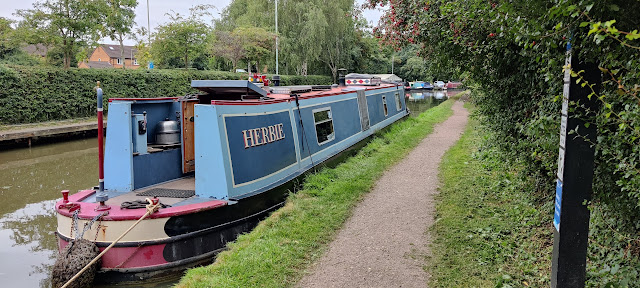British pub food is generally getting better over the years. I remember when you could hardly get more than a cheese sandwich. The one year when we were cruising down the Staffs and Worcester (it might have been on a hire boat so that would have been in the 1990s I think), the landlord of a pub showed us his first boil in the bag offering, supplied I suspect by Brake Brothers. I think it was a Boeuf Bourguignon, and a good step up from anything we'd had in a pub before. Pubs could now offer food of a 'reasonable' standard without having to have a trained chef. Such ready prepared food is now the staple of loads of pubs. Finding hostelries who prepare food from scratch is still not all that common.
Of our three nominees for best pub grub this year, I'm not entirely sure if they all prepared our meals from scratch. The Greyhound surely did my ploughman's lunch that way, and at the Boat our pizzas didn't taste or look like pre packaged ones. My pork belly at the Wharf may well have been bought in, but the veg with it were certainly fresh.
I could well award the Greyhound the Award again, but their trophy cabinet is already stuffed with Herbie Awards from previous years so this years
Herbie Award for Best Pub Grub
goes to
The Wharf at Fenny Compton
whose food is always wholesome and tasty and generously portioned. This year they seem to have stepped up the range somewhat too. So well done them.
Now onto the nominees for 2023 Favourite Place to Stop .
Of course, as ever, we can only choose from places we visited in the current year, so that limits us to North and South Oxford Canals, Coventry Canal and the Ashby Canal, plus Braunston on the GU.
Our nominees are:
1. Coventry Basin - always a pleasure, being a safe place to moor in the city in clean and relatively quiet surroundings. Here's Herbie in situ. I mean just look at it. What's not to like?
It's a very short walk into the city centre, the Cathedral, the excellent Transport Museum and all that good stuff. And within the basin there's a nice little cafe, ideal for afternoon tea of a yummy breakfast. Lots of boaters we talk to seem afraid to venture into Coventry, but trust me it's absolutely fine, and the run in from Hawkesbury junction is fine too especially since they seem to have established a volunteer group to keep the canal free of rubbish.
2.. Stoke Golding on the Ashby Canal - a hidden gem. It has two excellent mooring spots, one just the other side of the bridge from the Ashby Boat Company hire base, and the other on the bend at the other end of the village. Both have access to the village 10 minutes stroll up the hill, and a pretty and interesting village it is. The George and Dragon pub at the top is a cracker, serving the terrific Church End Brewery Ales in its very comfy lounge bar and pretty garden. The decisive civil war Battle of Bosworth Field took place nearby, so near in fact that the action was watched by the Stoke Golding villagers from the top of the church tower. After the battle, King Henry Tudor was given an impromptu crowning half way up the village hill and a plaque marks the spot.
Just down the lane from the bridge mooring is a handy farm shop selling enough food items to keep any hungry boater going (shops down the Ashby are a rarity). Here's one of the visitor moorings. It's got
mooring rings -woo hoo! And the boat hire base opposite sells ice creams.
3. Sutton Wharf - Ashby Canal
If they are open, don't go past without stopping. It's a very popular summer spot for canal watchers and the little cafe does very good real food (being real and made to order it might take a while for your order to arrive). Lots of picnic benches, plenty of boats to look at and just a few yards away among the bushes, a cosy little landing stage visitor mooring.
We stopped on a hot June afternoon and just enjoyed the ambience. The canal from here northwards is some of the best of the Ashby and in the summer is pretty as a picture.
The golden envelope will be opened in our next episode. Which one would you choose?
And well have nominees for Most Dramatic Moment. Ooo Er!!


















































